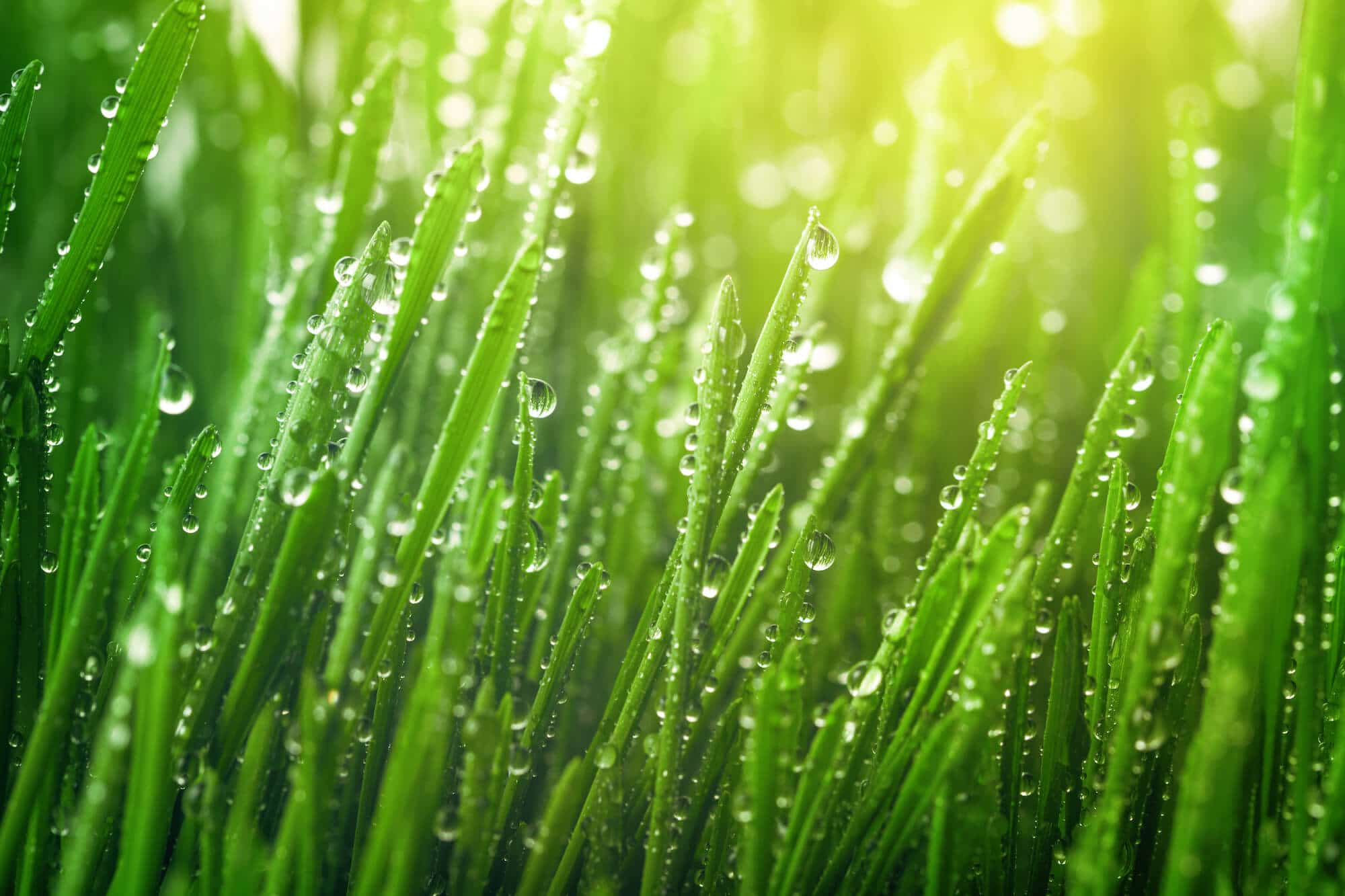How to Mow Wet Grass
It’s happened to all of us at one point or another—it’s been raining for a week straight with no end in sight and you really need to mow your lawn. While most of us know that mowing in wet weather isn’t ideal, it’s something that cannot be helped on some rare occasions.
Knowing how to mow effectively and safely when your grass is wet can help you keep your lawn safe and healthy without sacrificing the quality of your mower or putting yourself at risk.

Why Mow My Grass at All?
If it’s been raining for days or even weeks on end, it can be tempting to forget about mowing your lawn altogether. Though mowing might seem like a pointless task (especially when the weather is bad) it’s important to remember that mowing your lawn on a regular basis is crucial to maintaining the health of your grass. Here are a few of the biggest benefits that come with following a regular mowing schedule.
- Mowing keeps your lawn healthy: Your lawn is only as healthy as its roots. Unfortunately, when you allow your grass to grow too high, water and oxygen has a tougher time making it down to the roots of your grass. Mowing your lawn on a regular basis and maintaining a consistent height helps facilitate air and water flow between your soil and the atmosphere, which helps your grass grow in healthier and fuller.
- Fallen shoots of grass fertilize your lawn: Mowing your lawn doesn’t only help it look great immediately after you put the mower away—it can also help you cultivate a healthier lawn over time. After mowing, leave dry lawn clippings on your grass and allow your yard to enjoy an all-natural free fertilizer.
- Your grass becomes stronger over time: Another benefit of regularly cutting down your grass is that only the strongest, healthiest roots will be able to stay in your lawn. Over time, mowing your lawn consistently can leave you with healthier and fuller grass, as weaker shoots die off and are replaced with stronger blades of grass.
- Mowing distributes resources more evenly: Does your lawn regularly grow in clumps or patches? If it does, the answer might be to mow more often. Mowing reduces your grass blades to a uniform length, which results in water, oxygen, and other nutrients being more evenly distributed across your lawn.
- Depending on where you live, you might need to mow: If you live in an area with a homeowner’s association or other neighborhood control group, you might have regulations requiring you to keep your grass at a certain height. If you fail to keep your grass within these guidelines, you could face a fine from your homeowner’s association.
Even if you aren’t required to mow your lawn, regular mowing improves the exterior appearance of your property. This can add to your home’s curb appeal and even the value of your home if you decide to put your property up on the market.
Why You Shouldn’t Mow Wet Grass
You should avoid mowing your lawn when it’s wet for a variety of reasons. Mowing when your lawn is wet can result in a wide range of safety and grass health issues that you’ll want to avoid whenever possible. Here are just a few of the many reasons why you should do the vast majority of your mowing on days when the weather is dry.
- It can make your lawn look uneven: when you mow your grass, you want each blade of grass to be standing upright. This allows you to get an even, consistent length across your lawn. When grass is wet, it can become overly saturated in select parts of your lawn, causing the blades to droop down. After mowing a wet lawn, you’ll likely notice that your grass is uneven and even patchy—and in some extreme cases, you might even need to mow again later to get the look you need.
- Mowing wet grass can leave your lawn susceptible to disease: When you mow wet grass, you’re not cutting erect blades like you typically do when you mow your lawn dry. Instead, the resulting cut is similar to tearing the top of the grass blade, which can damage the health of your lawn and leave it more susceptible to diseases.
Fungal diseases are a notorious culprit when it comes to post-rainfall lawn infections. Fungi require a cool, damp environment in order to take root. When you mow your lawn when wet, you expose the interior of your grass to any fungal spores that happen to be in your lawn, which creates the ideal environment for infection. If you allow clumps of wet grass to rest on your lawn, you might even see a stubborn fungal infection called “brown spot” emerge in your yard. Avoid the hassle of treating these types of lawn diseases by mowing your lawn only when it’s dry out.
- It’s bad for your soil too: Mowing while your grass is wet isn’t only bad for your grass’s health—it can also harm the quality of your soil. After a heavy rainstorm, your soil becomes more malleable. When you run a lawnmower over damp soil, the wheels of the mower can sink into the ground and damage the roots of your grass. This can also cause your soil to become compacted, which makes it more difficult for your grass to get the oxygen and nutrients it needs to grow.
- Mowing while your lawn is wet is dangerous: If you have a riding lawnmower, you’re at a higher risk of tipping over when you mow on wet grass. Riding a mower on a wet, slippery lawn can create a hydroplaning effect, which can put you at risk of injury.
- Wet grass clippings can damage your mower: Moisture can mean major problems for your lawn mower—especially if it’s able to mix with the gasoline in your tank. Clumps of wet grass can also get caught in the wheels or blades of your lawnmower, which can be a hassle to correct after you’re finished.
Mowing your lawn while it’s wet can leave you with more work and a lawn that looks patchy or uneven. It can even be unsafe if you attempt to operate a riding lawnmower on a wet patch of grass.
Tips For Mowing Wet Grass
In some circumstances, you may not be able to avoid mowing your lawn when it’s wet. Thankfully, there are a few steps and precautions you can take to mow your lawn effectively and safely, even after a rain shower.
Use only safe mowers
Though no type of lawnmower was built to mow wet grass, certain types of mowers do better in damp environments than others. The best type of lawnmower you can use on wet grass is a manual push mower, but gas-powered push mowers can also be used safely after it rains.
Never use a riding mower on wet grass, as this type of mower can easily roll over and injure you even on a small slippery incline. You should also never use an electric mower on wet grass, as the water on your lawn may conduct electricity from your lawnmower and electrocute you. If you live in the Northeastern United States or another area where rainstorms are regular occurrences, you’ll likely want to invest in a type of mower that’s safe for use on wet grass.
Set your mower up for success
You can also optimize your lawnmower’s setting to avoid damaging your grass. Here are a few steps you should take before you begin mowing.
- Sharpen your lawn mower blades: Sharpening your lawn mower blades will help you avoid the “tearing” effect of cutting wet blades of grass. Be sure to sharpen your blades regularly, especially if you live in an area where rain storms are common.
- Raise your mower deck: In damp conditions, you’ll want to mow between three and four inches high to prevent clogging your mower or scalping your lawn. Set your mower to its highest setting before you begin. If you don’t like your grass on the longer side, remember that you can always return when your lawn is drier to refine the length.
- Clean out your mower deck: If you need to mow a wet lawn, you should always start with a clear deck. This helps prevent clogs and damage to your mower.
Taking just a few minutes to adjust your mower’s settings can mean the difference between a healthy lawn and a damaged lawn mower when it comes to cutting wet grass.
Add stabilizer to your fuel
Gasoline contains a compound called “ethanol” which can easily bond to moisture in the atmosphere or your grass and render it less effective at utilizing energy. If you need to mow a wet lawn, it’s important to add a stabilizer to your fuel. This will prevent the gasoline from bonding with moisture in your grass or the atmosphere while you’re mowing.
You should also avoid buying more gasoline than you can use in two weeks’ time if you live in an area with higher humidity or rainier weather. Purchasing only the amount of gasoline that you need will help you save money and retain the effectiveness of all fuel you purchase.
Mow carefully
Once your lawnmower is ready to go and you’ve stabilized your fuel, you can begin mowing your lawn. Depending on the length of your grass and your lawn’s condition, you might want to use a slower speed to prevent skidding. Be aware of your footing and wear shoes with plenty of traction to avoid slipping and falling.
Clean up after you mow
As you mow a wet lawn, you’ll want to avoid bagging or mulching your lawn clippings. Instead, use the side-discharge setting, which will leave clippings on your lawn. After you finish mowing be sure to clean up your lawn clippings to avoid future issues with fungal infections.
You should also take time to clean off your mower after you use it on wet grass as well. Wipe down the blades of your lawnmower and scrape the deck clean. Use a wire brush to clean any stray grass clippings from the wheels of your lawnmower. This will help keep your mower in its best possible condition.
Mow more often in the future
If you live in an area where heavy rainstorms are common, you may want to increase your mowing schedule and mow more than once a week. Mowing more often prevents your lawn from becoming too shaggy, which is more difficult to cut when wet.
Keeping Your Lawn Looking Gorgeous
Every homeowner wants to keep their lawn looking lush and green throughout the year. Unfortunately, not everyone has the time or expertise to give their lawn the TLC it needs to thrive. If you’re dealing with a stubborn lawn care issue, call the team at TruGreen in to take care of it for you. TruGreen is your local source for all of the lawn care services your grass needs to stay healthy. Give our team a call today at 877-349-9084 to learn more.







